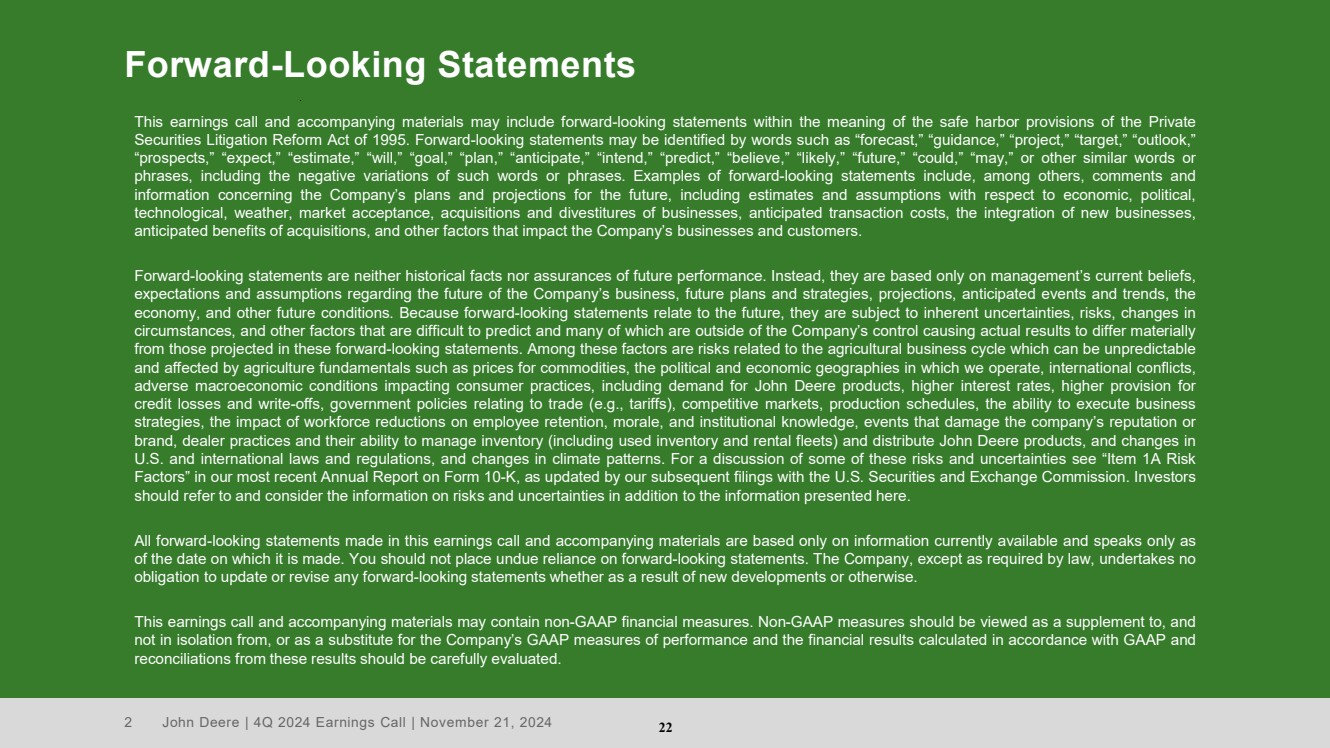
| 2 John Deere | 4Q 2024 Earnings Call | November 21, 2024
Forward-Looking Statements
This earnings call and accompanying materials may include forward-looking statements within the meaning of the safe harbor provisions of the Private
Securities Litigation Reform Act of 1995. Forward-looking statements may be identified by words such as “forecast,” “guidance,” “project,” “target,” “outlook,”
“prospects,” “expect,” “estimate,” “will,” “goal,” “plan,” “anticipate,” “intend,” “predict,” “believe,” “likely,” “future,” “could,” “may,” or other similar words or
phrases, including the negative variations of such words or phrases. Examples of forward-looking statements include, among others, comments and
information concerning the Company’s plans and projections for the future, including estimates and assumptions with respect to economic, political,
technological, weather, market acceptance, acquisitions and divestitures of businesses, anticipated transaction costs, the integration of new businesses,
anticipated benefits of acquisitions, and other factors that impact the Company’s businesses and customers.
Forward-looking statements are neither historical facts nor assurances of future performance. Instead, they are based only on management’s current beliefs,
expectations and assumptions regarding the future of the Company’s business, future plans and strategies, projections, anticipated events and trends, the
economy, and other future conditions. Because forward-looking statements relate to the future, they are subject to inherent uncertainties, risks, changes in
circumstances, and other factors that are difficult to predict and many of which are outside of the Company’s control causing actual results to differ materially
from those projected in these forward-looking statements. Among these factors are risks related to the agricultural business cycle which can be unpredictable
and affected by agriculture fundamentals such as prices for commodities, the political and economic geographies in which we operate, international conflicts,
adverse macroeconomic conditions impacting consumer practices, including demand for John Deere products, higher interest rates, higher provision for
credit losses and write-offs, government policies relating to trade (e.g., tariffs), competitive markets, production schedules, the ability to execute business
strategies, the impact of workforce reductions on employee retention, morale, and institutional knowledge, events that damage the company’s reputation or
brand, dealer practices and their ability to manage inventory (including used inventory and rental fleets) and distribute John Deere products, and changes in
U.S. and international laws and regulations, and changes in climate patterns. For a discussion of some of these risks and uncertainties see “Item 1A Risk
Factors” in our most recent Annual Report on Form 10-K, as updated by our subsequent filings with the U.S. Securities and Exchange Commission. Investors
should refer to and consider the information on risks and uncertainties in addition to the information presented here.
All forward-looking statements made in this earnings call and accompanying materials are based only on information currently available and speaks only as
of the date on which it is made. You should not place undue reliance on forward-looking statements. The Company, except as required by law, undertakes no
obligation to update or revise any forward-looking statements whether as a result of new developments or otherwise.
This earnings call and accompanying materials may contain non-GAAP financial measures. Non-GAAP measures should be viewed as a supplement to, and
not in isolation from, or as a substitute for the Company’s GAAP measures of performance and the financial results calculated in accordance with GAAP and
reconciliations from these results should be carefully evaluated.
22 |